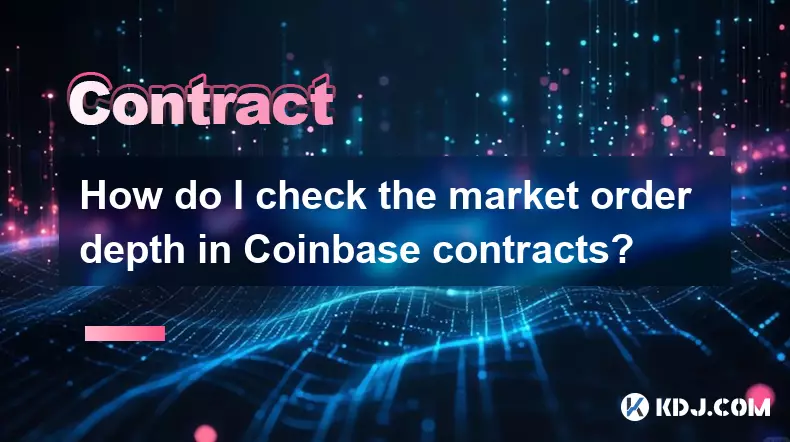-
 bitcoin
bitcoin $122025.899241 USD
-2.12% -
 ethereum
ethereum $4488.068729 USD
-4.11% -
 bnb
bnb $1315.348019 USD
8.65% -
 tether
tether $1.000457 USD
0.03% -
 xrp
xrp $2.875326 USD
-3.69% -
 solana
solana $222.043604 USD
-4.07% -
 usd-coin
usd-coin $0.999682 USD
0.00% -
 dogecoin
dogecoin $0.249887 USD
-5.62% -
 tron
tron $0.337379 USD
-2.59% -
 cardano
cardano $0.827763 USD
-5.06% -
 hyperliquid
hyperliquid $45.774531 USD
-2.43% -
 chainlink
chainlink $22.079309 USD
-5.87% -
 ethena-usde
ethena-usde $1.000156 USD
0.02% -
 sui
sui $3.482566 USD
-3.57% -
 stellar
stellar $0.386982 USD
-4.92%
How do I check the market order depth in Coinbase contracts?
A deep order book on Coinbase signals high liquidity, reducing slippage and enabling larger trades at stable prices.
Sep 18, 2025 at 08:18 am

Understanding Market Order Depth on Coinbase
1. Market order depth is a crucial metric for traders engaging in cryptocurrency derivatives on platforms like Coinbase. It reflects the volume of buy and sell orders at various price levels, providing insight into market liquidity and potential price movement. On Coinbase's futures or contracts platform, accessing this data allows users to make informed decisions based on real-time supply and demand dynamics.
2. To view order depth, navigate to the trading interface for the specific contract pair you're analyzing. The order book is typically displayed alongside the price chart. This panel shows two columns: one for pending buy orders (bids) and another for sell orders (asks). The depth increases as more orders accumulate at different price points.
3. The visual representation of order depth often includes a depth chart, which plots cumulative volume against price. A steep slope indicates strong support or resistance, while a gradual incline suggests weaker pressure. Traders use this to anticipate breakout points or determine optimal entry and exit positions.
4. Refresh rates for the order book are near-instantaneous on Coinbase, ensuring high accuracy. However, during periods of high volatility, slight delays may occur due to network congestion or API limitations. Monitoring the timestamp on updates helps assess data freshness.
5. Customization options allow users to filter the depth by quantity or price range. Some advanced tools let traders overlay historical depth patterns to compare current market structure with past behavior, enhancing strategic planning.
Accessing the Order Book Interface
1. Log into your Coinbase account and switch to the advanced trade section where futures or perpetual contracts are listed. Select the desired trading pair such as BTC-USD or ETH-USD futures.
2. Locate the central workspace divided into multiple panels. The order book is usually positioned on the left or right side of the main price chart. If not visible, check for a toggle button labeled 'Order Book' or 'Depth.'
3. Clicking on an individual bid or ask entry will pre-fill the order form with that price. This feature enables rapid execution based on current market depth without manual input.
4. The displayed levels can be adjusted to show top 10, 20, or 50 entries. Increasing the number provides broader context but may clutter the view. Most active traders prefer a balanced setting that captures immediate liquidity without noise.
5. Real-time updates are reflected as color-coded changes—green for new bids, red for new asks. Sudden clustering of large orders at a specific price level often signals institutional interest or algorithmic activity.
Analyzing Liquidity Through Depth Charts
1. The depth chart sits beneath or adjacent to the order book and presents a graphical version of the same data. X-axis represents price, Y-axis shows cumulative volume. Bids extend to the left from the current price, asks to the right.
2. A thick wall on either side of the chart indicates strong market conviction at that price. For example, a dense cluster of sell orders above the current price may act as resistance, limiting upward movement until absorbed.
3. Thin zones suggest fragile support or resistance. Prices tend to move rapidly through these areas, especially when triggered by news or macroeconomic events affecting the crypto market.
4. Traders monitor imbalances between buy and sell volume. An oversized bid stack relative to asks could foreshadow a short squeeze if momentum builds in that direction.
5. Historical depth snapshots aren't stored by default, so third-party analytics tools are sometimes used to archive and study structural shifts over time. These help identify recurring patterns tied to funding rate cycles or expiration dates.
Using APIs for Advanced Depth Analysis
1. Coinbase offers a robust API suite that delivers raw order book data in JSON format. Developers can pull full or incremental updates at sub-second intervals depending on subscription tier.
2. The endpoint /marketbook/{contract_symbol} returns all active bids and asks with price, size, and number of orders at each level. This granularity supports algorithmic strategies relying on microstructure analysis.
3. Rate limits apply to prevent system overload. Public endpoints allow higher frequency access than private ones, but authentication is required for personalized data streams.
4. WebSocket connections enable push-based delivery of order book changes, reducing latency compared to polling methods. Subscribing to channels like 'level2' provides aggregated depth updates essential for high-frequency operations.
5. Parsing the data requires handling sequence numbers to maintain integrity. Missing messages must be re-requested via snapshot endpoints to avoid corrupted state in automated systems.
Frequently Asked Questions
What does a deep order book indicate on Coinbase contracts?A deep order book signifies high liquidity, meaning there are substantial buy and sell orders across multiple price levels. This reduces slippage and allows larger trades to execute closer to expected prices.
Can I see hidden orders in the market depth?No, Coinbase does not display hidden or iceberg orders in the public order book. Only visible resting orders appear in the depth feed. Large players may split orders manually to mimic such behavior.
How often is the order depth updated?Updates occur in real-time, typically within milliseconds of a change. Websocket feeds provide the fastest refresh rates, critical for active trading strategies sensitive to order flow shifts.
Is order book data available for all contract types on Coinbase?Yes, both quarterly futures and perpetual contracts have accessible depth information. However, less-traded pairs may exhibit thinner books with wider spreads and lower overall volume.
Disclaimer:info@kdj.com
The information provided is not trading advice. kdj.com does not assume any responsibility for any investments made based on the information provided in this article. Cryptocurrencies are highly volatile and it is highly recommended that you invest with caution after thorough research!
If you believe that the content used on this website infringes your copyright, please contact us immediately (info@kdj.com) and we will delete it promptly.
- BlockDAG, DOGE, HYPE Sponsorship: Crypto Trends Shaping 2025
- 2025-10-01 00:25:13
- Deutsche Börse and Circle: A StableCoin Adoption Powerhouse in Europe
- 2025-10-01 00:25:13
- BlockDAG's Presale Buzz: Is It the Crypto to Watch in October 2025?
- 2025-10-01 00:30:13
- Bitcoin, Crypto, and IQ: When Genius Meets Digital Gold?
- 2025-10-01 00:30:13
- Stablecoins, American Innovation, and Wallet Tokens: The Next Frontier
- 2025-10-01 00:35:12
- NBU, Coins, and Crypto in Ukraine: A New Yorker's Take
- 2025-10-01 00:45:14
Related knowledge

What is the difference between futures and perpetual contracts for Bitcoin?
Oct 02,2025 at 11:54pm
Understanding Bitcoin Futures Contracts1. Bitcoin futures are derivative instruments that allow traders to speculate on the future price of Bitcoin at...

What is the best time to trade PEPE contracts?
Oct 03,2025 at 11:54am
Understanding PEPE Contract Volatility1. PEPE contracts exhibit extreme price fluctuations due to their meme-based nature and low market cap. Trading ...

What are the common mistakes to avoid with Bitcoincoin contracts?
Oct 03,2025 at 08:54am
Emerging Trends in the Cryptocurrency Market1. Decentralized finance (DeFi) platforms continue to expand their influence across the blockchain ecosyst...

What is the maintenance margin for Bitcoin contracts?
Oct 02,2025 at 01:36am
Decentralized Exchanges Gain Momentum in 20241. Decentralized exchanges (DEXs) have seen a significant rise in trading volume, surpassing centralized ...

How to use technical analysis for trading XRP contracts?
Oct 03,2025 at 01:18pm
Understanding Price Patterns in XRP Futures1. Identifying chart patterns such as triangles, head and shoulders, and double tops or bottoms can provide...

What does "longing" PEPE contracts mean?
Oct 03,2025 at 11:54pm
Understanding Decentralized Exchanges in the Crypto Ecosystem1. Decentralized exchanges (DEXs) operate without a central authority, allowing users to ...

What is the difference between futures and perpetual contracts for Bitcoin?
Oct 02,2025 at 11:54pm
Understanding Bitcoin Futures Contracts1. Bitcoin futures are derivative instruments that allow traders to speculate on the future price of Bitcoin at...

What is the best time to trade PEPE contracts?
Oct 03,2025 at 11:54am
Understanding PEPE Contract Volatility1. PEPE contracts exhibit extreme price fluctuations due to their meme-based nature and low market cap. Trading ...

What are the common mistakes to avoid with Bitcoincoin contracts?
Oct 03,2025 at 08:54am
Emerging Trends in the Cryptocurrency Market1. Decentralized finance (DeFi) platforms continue to expand their influence across the blockchain ecosyst...

What is the maintenance margin for Bitcoin contracts?
Oct 02,2025 at 01:36am
Decentralized Exchanges Gain Momentum in 20241. Decentralized exchanges (DEXs) have seen a significant rise in trading volume, surpassing centralized ...

How to use technical analysis for trading XRP contracts?
Oct 03,2025 at 01:18pm
Understanding Price Patterns in XRP Futures1. Identifying chart patterns such as triangles, head and shoulders, and double tops or bottoms can provide...

What does "longing" PEPE contracts mean?
Oct 03,2025 at 11:54pm
Understanding Decentralized Exchanges in the Crypto Ecosystem1. Decentralized exchanges (DEXs) operate without a central authority, allowing users to ...
See all articles










































































